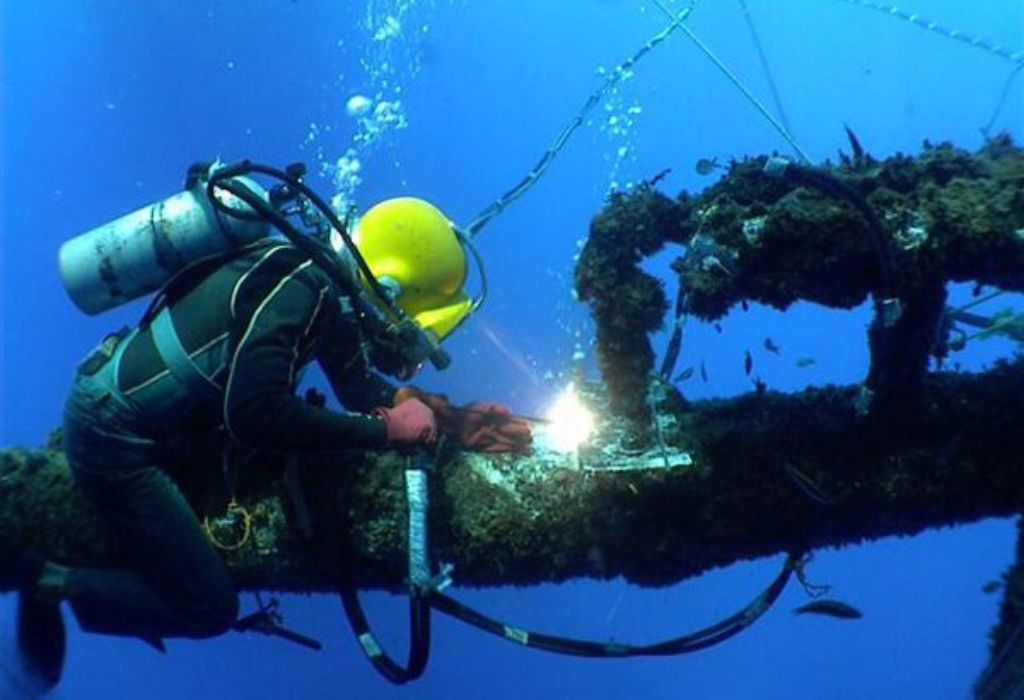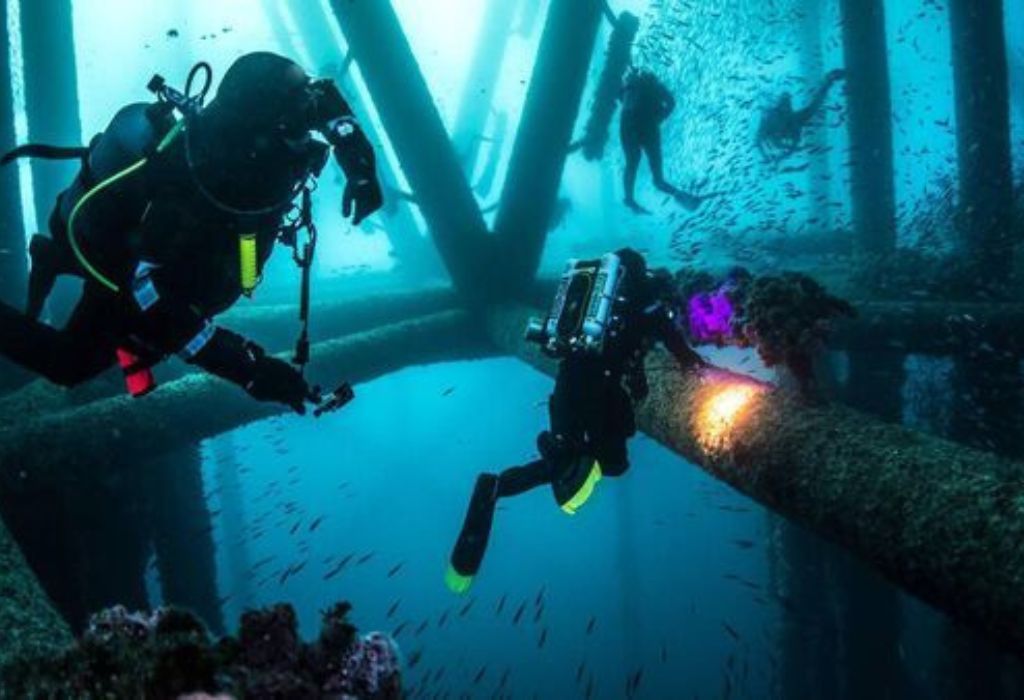Beneath the ocean’s surface, where sunlight fades and pressure builds, sparks of molten metal illuminate the dark.
This is where underwater welders perform one of the most dangerous and fascinating jobs on the planet.
The concept seems impossible — electricity and water shouldn’t mix — yet underwater welding makes it work every single day.
It’s the process that keeps oil rigs stable, repairs ship hulls, and maintains offshore pipelines deep below the waves.
When corrosion, cracks, or damage threaten billion-dollar structures, underwater welders step in to save them.
Each weld is performed in freezing water, under crushing pressure, and often in near-zero visibility.
The combination of danger and skill makes this career one of the highest-paying jobs in the welding industry.
According to the U.S. Bureau of Labor Statistics, commercial divers and underwater welders earn an average of $55,270 per year, with elite professionals exceeding $100,000+ annually (source).
But it’s not just about the paycheck — it’s about precision, courage, and understanding how science meets craftsmanship under extreme conditions.
To perform a safe underwater weld, divers must control electricity, pressure, and chemistry at the same time.
They rely on specialized tools, waterproof electrodes, and strict safety procedures to keep the arc stable in a liquid environment.
Each weld forms inside a gas bubble, created by electrical heat and shielding compounds, as the diver manipulates molten metal beneath tons of water.
This guide explores how underwater welding works — the methods, physics, equipment, and safety systems that make it possible.
By the end, you’ll understand why this process is considered both an engineering marvel and a test of human endurance.
What Is Underwater Welding?

Underwater welding is a specialized process that joins metal components while submerged in water.
It’s a critical skill for maintaining and repairing ships, oil rigs, underwater pipelines, and offshore structures.
Unlike traditional welding done in dry environments, this technique merges diving expertise with advanced welding technology.
It allows repairs to be performed directly on-site without lifting massive structures out of the ocean.
There are two main types of underwater welding — wet welding and dry hyperbaric welding.
In wet welding, the welder performs the task directly in the water, while in dry welding, a sealed chamber filled with gas surrounds the work area.
Both methods require precise control of electric current, temperature, and gas shielding to ensure safety and structural integrity.
The process not only bonds metal but also withstands immense underwater pressure, temperature changes, and corrosion.
Underwater welding is essential to the global marine industry, with applications ranging from bridge foundations to offshore energy platforms.
It plays a vital role in preventing catastrophic failures and extending the life of underwater assets.
What is the purpose of underwater welding?
It allows permanent metal repairs and fabrication in submerged environments without removing the structure.
What makes underwater welding different from regular welding?
It combines high-pressure diving with electrical arc welding using waterproof electrodes and insulated tools.
Where is underwater welding most commonly used?
In ship maintenance, oil rig repairs, pipeline restoration, and underwater construction projects.
How Does Underwater Welding Work?
At its core, underwater welding relies on the same principle as topside welding — fusing metals using heat from an electric arc.
The main difference is how that arc behaves and how it’s controlled under high water pressure.
When the welder strikes the arc, the electrical current passes through a waterproof electrode and creates intense heat.
That heat melts both the base metal and the electrode, forming a molten metal pool that solidifies into a joint once cooled.
Because water conducts electricity, the process requires direct current (DC) instead of alternating current to reduce shock risk.
The entire system is powered through specialized underwater cables with heavy insulation for safety.
The weld area is shielded by gas bubbles produced from the burning flux on the electrode tip.
These bubbles form a temporary protective zone around the molten metal, preventing contamination by water and oxygen.
What type of current is used in underwater welding?
Direct current (DC) is used because it provides stable arcs and minimizes electrical hazards in water.
What keeps the arc from being extinguished underwater?
A gas bubble forms around the weld zone, isolating it from water and allowing the arc to remain stable.
How hot is underwater welding?
The temperature can reach 10,000°F (5,500°C) — hot enough to melt most metals instantly.
Wet vs. Dry Underwater Welding
There are two primary approaches: wet welding and dry hyperbaric welding.
Both have unique advantages depending on depth, location, and project requirements.
Wet welding is performed directly in the water using special waterproof electrodes.
It’s faster, cheaper, and ideal for emergency repairs in shallow or moderate depths.
However, wet welds are more prone to porosity, cracking, and oxidation due to constant water exposure.
This method also exposes welders to electric shock, decompression sickness, and limited visibility.
Dry welding, on the other hand, uses a sealed chamber (called a habitat) around the welding area.
The chamber is filled with a dry gas mixture, allowing the diver to weld as if on land.
This approach produces higher-quality welds and offers better protection against water contamination.
But it’s expensive, time-consuming, and requires precise pressure regulation inside the habitat.
Which type of underwater welding is safer?
Dry hyperbaric welding is safer because it isolates the welder and the arc from direct water contact.
Why is wet welding still used?
It’s cost-effective, fast, and ideal for temporary or shallow-water repairs.
What gas is used in dry underwater welding?
A mixture of helium and oxygen maintains a breathable, dry environment inside the welding habitat.
Tools and Equipment Used in Underwater Welding
The success of underwater welding depends heavily on specialized equipment designed for harsh marine environments.
Each tool must resist corrosion, pressure, and electrical hazards while maintaining precision underwater.
The core tools include underwater welding machines, waterproof electrodes, and insulated stingers.
Divers also wear heavy-duty drysuits or wetsuits, weighted boots, and full-face diving helmets with communication systems.
For dry welding, hyperbaric chambers are used to create a controlled atmosphere around the welding zone.
Additional equipment includes hydraulic clamps, grinders, and cutting torches for preparing and finishing weld joints.
All components are inspected before every dive to ensure functionality and safety compliance.
Even a minor leak or faulty connection can jeopardize the diver’s safety and the quality of the weld.
What kind of electrodes are used for underwater welding?
Special waterproof electrodes such as E6013 or E7014 are most commonly used.
How do welders communicate underwater?
They use hardwired communication systems integrated into their helmets.
What depth can underwater welders work at?
Commercial welders typically operate between 10 to 300 feet, depending on certification and project scope.
Safety Risks and Challenges
Underwater welding is as dangerous as it is essential.
The combination of electricity, pressure, and human endurance creates several serious risks.
The biggest hazards include electric shock, decompression sickness, drowning, and explosions.
Decompression sickness, also known as “the bends,” occurs when divers ascend too quickly after deep welding.
Welders also face nitrogen narcosis, which impairs judgment at extreme depths.
Limited visibility, poor currents, and sharp metal edges make every movement underwater potentially hazardous.
Despite these risks, proper training, teamwork, and advanced equipment make the job manageable.
Most accidents occur due to human error or equipment failure rather than the welding process itself.
Is underwater welding the most dangerous job?
It’s among the top high-risk professions but with strict protocols, it’s significantly safer than in earlier decades.
How do divers avoid electric shock?
They use DC power, waterproof insulation, and constant monitoring by surface safety teams.
What causes explosions during underwater welding?
Hydrogen and oxygen gases can accumulate and ignite if not properly vented.
Applications of Underwater Welding

Underwater welding supports industries vital to global infrastructure.
From oil extraction to naval maintenance, its impact reaches across multiple sectors.
In oil and gas, welders repair subsea pipelines, platforms, and risers critical for fuel transport.
In shipping, they handle hull repairs, propeller maintenance, and corrosion control without dry-docking vessels.
Other industries include bridge construction, dam reinforcement, and renewable ocean energy systems.
Each project demands precision welding that can withstand intense pressure and corrosion.
As global offshore projects expand, skilled underwater welders are increasingly in demand.
This specialization ensures the stability and longevity of marine engineering worldwide.
What industries rely on underwater welding?
Oil and gas, shipping, military, construction, and renewable energy sectors.
Can underwater welding be done on freshwater structures?
Yes, it’s used in lakes, rivers, and dam environments where corrosion control is needed.
Is automation used in underwater welding?
Yes, remotely operated welding robots are now being developed for deep-sea applications.
Future of Underwater Welding
Technology continues to evolve, making underwater welding safer and more efficient.
Advancements in robotics, AI, and remote-control systems are reshaping this dangerous trade.
Modern ROVs (Remotely Operated Vehicles) can perform welding tasks at extreme depths where human divers cannot reach.
AI-assisted monitoring systems help detect weld quality and environmental conditions in real time.
New materials and electrodes are being engineered to resist corrosion and reduce hydrogen embrittlement.
Meanwhile, simulation-based diver training enhances preparedness for complex underwater operations.
In the coming years, underwater welding will likely blend human expertise with robotic precision.
This combination will lower accident rates while maintaining the craftsmanship that defines the trade.
Will robots replace human underwater welders?
Not entirely — human skill and adaptability remain crucial for complex and emergency operations.
What new technologies are improving safety?
AI sensors, predictive maintenance software, and high-definition underwater cameras.
Are there eco-friendly innovations in welding underwater?
Yes, researchers are developing non-toxic flux materials to reduce marine contamination.
Conclusion
Underwater welding is one of the most remarkable feats of human engineering.
It merges science, precision, and bravery to solve problems in places few people dare to work.
Through the use of electric arcs, specialized tools, and strict safety systems, welders create lasting metal bonds beneath the waves.
Their work keeps global industries afloat — from oil production to bridge construction and beyond.
Understanding how underwater welding works reveals not only the complexity of the process but also the resilience of the people behind it.
Each weld made underwater represents a blend of courage, technology, and skill under extreme pressure.
For anyone drawn to the challenge, underwater welding remains a career that demands respect — and delivers adventure unlike any other.

I’m Darrell Julian, the founder, lead writer, and hands-on welding enthusiast behind ArcWeldingPro.com. With more than 15 years of real-world welding experience, I created this platform to share what I’ve learned in the field, in the shop, and in the heat of the arc.


